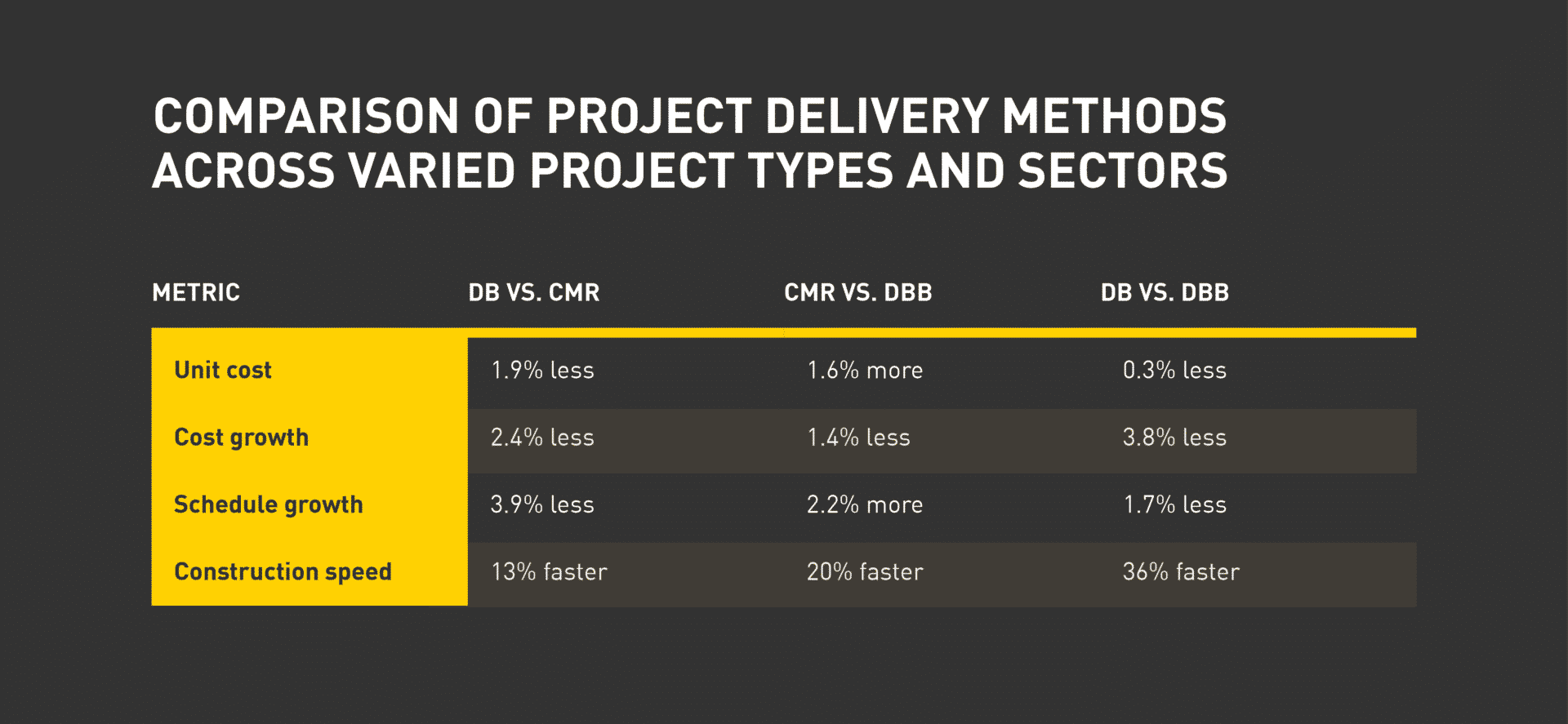Benefits of Design Build
Design-Build offers many unique benefits and advantages that other construction methods simply don’t deliver. It’s why 90 percent of our projects are Design-Build. Some of the biggest benefits of Design-Build are rapid delivery, a smooth process, better solutions and better communication.
Rapid delivery
As we covered in the Design-Build process section, Design-Build offers rapid delivery because design and construction happen concurrently and because there’s only one selection phase instead of two. The delivery method turns otherwise impossible timeframes into reality.
Smooth process
Time and again, Design-Build reliably equates to headaches eliminated, teams collaborating and owners pleased. The single-source responsibility afforded by Design-Build means there’s no conflicting recommendations from contractor and architect. Instead, one entity has total accountability for any and all construction and design elements. Owners know where the buck stops, and the way is paved for a smooth owner experience.
Better solutions and better value
In Design-Build, there’s no need to limit solutions to traditional ideas. The job is the boss. So teams are only limited by what’s right for the job. As ideas come to the table, teams work as one unit to analyze them, in full transparency, so owners are assured of getting the best materials, siting, schedule, design and more. This innovative process makes it possible for owners to see more options, make better-informed decisions and realize a better value.
Better communication and fewer problems
Delivering a successful Design-Build project requires open collaboration between all team members. Creating a team-oriented approach promotes high levels of communication and transparency, both imperative to the success of any project. It allows owners to share their vision with the team, and align the interests of the stakeholders. The team-oriented approach also provides the collaborative effort necessary to evaluate the project’s objectives, assess schedules and analyze opportunities as the project progresses. As a team, no other group is better qualified to align the owner’s vision with the project’s goals and objectives.Design-Build facilitates it. All team members stay on the same page because everyone is working under one contract. And owners are kept up to date by a set contact from the Design-Builder. As a result, Design-Build is well suited for the most complex jobs, simplifying them so owners realize better quality, require fewer claims and receive litigation-free builds.
Design-Build cost savings
Due to its efficiency, Design-Build often reduces construction costs for owners. This may come as a surprise, given that Design-Build projects lack the hard-dollar bid phase that general contracting affords. But building smart with Design-Build pays dividends, reducing both real (accounting) costs and opportunity costs. In this section, we show you how Design-Build reduces these costs. To further explore the topic of construction costs and how to plan for them, see our guide to construction finance.
Design-Build reduces project costs
A Design-Build Institute of America study from 2018 revealed how much time and money Design-Build saves when compared other delivery methods. It’s clear that Design-Build projects are delivered faster, more cost-efficiently and with fewer change orders that lead to unforeseen costs and schedule delays. In other words, Design-Build helps jobs get done on-time and on-budget. Based on numbers from that study, the chart below compares the time and money savings Design-Build provides against design-bid-build (DBB) and construction manager at risk (CMR).
Taking just one of these metrics, construction speed, if a CMR job is projected to take a year, that same job under Design-Build would wrap up around a month and a half early. A projected one-year DBB project would take less than eight months to complete if it was Design-Build instead.
Design-Build reduces opportunity costs
In many builds, Design-Build saves more in opportunity costs than it saves in accounting costs. Due to the smooth nature of Design-Build project delivery, owners can reduce time spent managing a build. And time is money. That’s time that can be put to use solving other business challenges.
In the specialty case of manufacturing or distribution construction projects in which producers and distributors expand operations, the sooner a facility opens or expands, the sooner production can increase and the sooner profits can be realized. For some manufacturers and distributors, a single day of lost productivity could cost hundreds of thousands of dollars. So the speed of Design-Build becomes highly valuable.
Taking just one of these metrics, construction speed, if a CMR job is projected to take a year, that same job under Design-Build would wrap up around a month and a half early. A projected one-year DBB project would take less than eight months to complete if it was Design-Build instead.
Selecting Design Build firms
Design-Build is a two-sided coin. Its greatest strength is the single-source responsibility it affords, and its greatest weakness is the risk associated with one Design-Builder holding all project responsibility. If you choose Design-Build, it’s more critical than ever that you select an honest, experienced builder you can trust. In this section, we cover some of the key traits to consider as you select Design-Build firms.
Key traits of sound Design-Build firms
When evaluating Design-Builders, choose a Design-Build firm you can count as a partner. What does a partner do?
In our estimation, a partner is willing to contract flexibly with you and pass savings back to you. If a build comes in under budget and your contract doesn’t allow you to share in savings, then it incentivizes cutting corners. But if you share in any savings when a build comes in under budget, you, together with your Design-Build partner, incentivize quality.
Last but not least, your Design-Builder should have a long list of strong references and a portfolio of projects similar to yours. And throughout your project, Design-Build firms should have great communication systems in place so you’re always up to date and able to report progress to other stakeholders.



